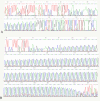High frequency of Machado-Joseph disease identified in southeastern Chinese kindreds with spinocerebellar ataxia
- PMID: 20334689
- PMCID: PMC2861663
- DOI: 10.1186/1471-2350-11-47
High frequency of Machado-Joseph disease identified in southeastern Chinese kindreds with spinocerebellar ataxia
Abstract
Background: Machado-Joseph disease (MJD), caused by a CAG repeat expansion located in exon10 of the ATXN3 gene, is now regarded as one of the most common spinocerebellar ataxia (SCA) in the world. The relative frequency of MJD among SCA has previously been estimated at about 50% in the Chinese population and has been reported to be related to the frequency of large normal alleles in some populations. Taq polymerase has been used for PCR in nearly all studies reported previously.
Methods: Normal and expanded alleles of ATXN3 were detected via PCR using LA Taq DNA polymerase (better for GC-rich sequences) and denaturing polyacrylamide gel electrophoresis in 150 normal individuals and 138 unrelated probands from autosomal dominant SCA families. To compare reaction efficiency, 12 MJD patients' expanded alleles were amplified with La Taq and Taq polymerase respectively in the same amplifying systems and reaction conditions.
Results: Normal alleles ranged from 12 to 42 CAG repeats. The most common allele contained 14 repeats with a frequency of 23.3%, which corroborates previous reports. The frequency of large normal alleles (>27 repeats) was 0.28, which was very high relative to previous reports. The frequency of MJD in SCA patients was 72.5%, which was significantly higher than those in previous reports about the Chinese and other Asian populations. This frequency was one of the highest reported worldwide, with only Portuguese and Brazilian populations exhibiting higher proportions. All 12 expanded alleles were amplified in PCR with La Taq polymerase, whereas only 2 expanded alleles were amplified with Taq polymerase.
Conclusion: We have first reported the highest relative frequency of MJD in Asia, and we attribute this high frequency to a more efficient PCR using LA Taq polymerase and hypothesized that large ANs may act as a reservoir for expanded alleles in the Southeastern Chinese population.
Figures





Similar articles
-
Frequency of SCA1, SCA2, SCA3/MJD, SCA6, SCA7, and DRPLA CAG trinucleotide repeat expansion in patients with hereditary spinocerebellar ataxia from Chinese kindreds.Arch Neurol. 2000 Apr;57(4):540-4. doi: 10.1001/archneur.57.4.540. Arch Neurol. 2000. PMID: 10768629
-
Analysis of trinucleotide repeats in different SCA loci in spinocerebellar ataxia patients and in normal population of Taiwan.Acta Neurol Scand. 2004 May;109(5):355-60. doi: 10.1046/j.1600-0404.2003.00229.x. Acta Neurol Scand. 2004. PMID: 15080863
-
[Identification of ATXN3 intermedial allele associated with a disease phenotype in an SCA3 Han Chinese family].Zhonghua Yi Xue Yi Chuan Xue Za Zhi. 2010 Apr;27(2):190-3. doi: 10.3760/cma.j.issn.1003-9406.2010.02.016. Zhonghua Yi Xue Yi Chuan Xue Za Zhi. 2010. PMID: 20376803 Chinese.
-
Machado-Joseph disease/spinocerebellar ataxia type 3.Handb Clin Neurol. 2012;103:437-49. doi: 10.1016/B978-0-444-51892-7.00027-9. Handb Clin Neurol. 2012. PMID: 21827905 Free PMC article. Review.
-
Selective forces acting on spinocerebellar ataxia type 3/Machado-Joseph disease recurrency: A systematic review and meta-analysis.Clin Genet. 2021 Mar;99(3):347-358. doi: 10.1111/cge.13888. Epub 2020 Dec 2. Clin Genet. 2021. PMID: 33219521
Cited by
-
Quantitative assessment of postural instability in spinocerebellar ataxia type 3 patients.Ann Clin Transl Neurol. 2020 Aug;7(8):1360-1370. doi: 10.1002/acn3.51124. Epub 2020 Jul 7. Ann Clin Transl Neurol. 2020. PMID: 32638517 Free PMC article.
-
Ataxic Severity Is Positively Correlated With Fatigue in Spinocerebellar Ataxia Type 3 Patients.Front Neurol. 2020 Apr 22;11:266. doi: 10.3389/fneur.2020.00266. eCollection 2020. Front Neurol. 2020. PMID: 32390927 Free PMC article.
-
Genotype-phenotype correlation in Chinese patients with spinal and bulbar muscular atrophy.PLoS One. 2015 Mar 26;10(3):e0122279. doi: 10.1371/journal.pone.0122279. eCollection 2015. PLoS One. 2015. PMID: 25811990 Free PMC article.
-
Clinical features and genetic characteristics of homozygous spinocerebellar ataxia type 3.Mol Genet Genomic Med. 2020 Sep;8(9):e1314. doi: 10.1002/mgg3.1314. Epub 2020 Jul 9. Mol Genet Genomic Med. 2020. PMID: 32643267 Free PMC article.
-
Impaired Lower Limb Proprioception in Spinocerebellar Ataxia Type 3 and Its Affected Factors.Front Neurol. 2022 Feb 2;13:833908. doi: 10.3389/fneur.2022.833908. eCollection 2022. Front Neurol. 2022. PMID: 35185776 Free PMC article.
References
-
- Takiyama Y, Oyanagi S, Kawashima S, Sakamoto H, Saito K, Yoshida M, Tsuji S, Mizuno Y, Nishizawa M. A clinical and pathologic study of a large Japanese family with Machado-Joseph disease tightly linked to the DNA markers on chromosome 14q. Neurology. 1994;44:1302–1308. - PubMed
-
- Sequeiros J, Coutinho P. Epidemiology and clinical aspects of Machado-Joseph disease. Adv Neurol. 1993;61:139–153. - PubMed
-
- Kawaguchi Y, Okamoto T, Taniwaki M, Aizawa M, Inoue M, Katayama S, Kawakami H, Nakamura S, Nishimura M, Akiguchi I, Kimura J, Narumiya S, Kakizuka A. CAG repeat expansions in a novel gene for Machado-Joseeph disease at chromosome 14q32.1. Nature Genet. 1994;8:221–228. doi: 10.1038/ng1194-221. - DOI - PubMed
-
- NCBI Bookshelf-GeneReviews-Spinocerebellar Ataxia Type 3. http://www.ncbi.nlm.nih.gov/bookshelf/br.fcgi?book=gene&part=sca3
Publication types
MeSH terms
Substances
LinkOut - more resources
Full Text Sources
Miscellaneous

